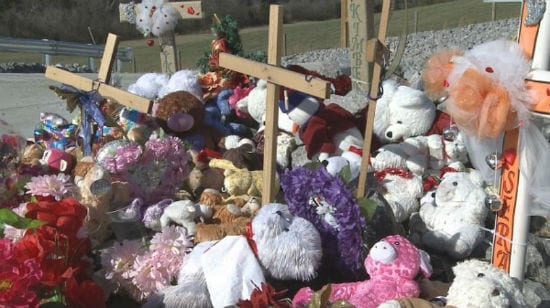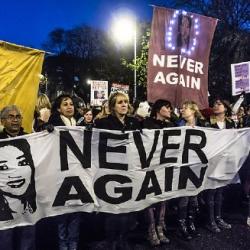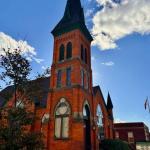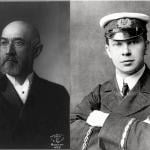Three thousand people lost their lives on 9/11. Last year, on this day, it was more than 4,000. Four thousand lives ended. Four thousand American lives snuffed out in their sleep.
The commemoration, the public mourning, the speechifying and grandstanding and collective mass-expression of all five Kubler-Ross stages of grief we should expect to see today should be greater than, or at least equal to, the mass-mourning we all felt and witnessed and participated in on September 11, 2002.
Because these were all children. These were innocent babies.
In Cleveland there would be an impromptu shrine — one of those street memorials that we Americans spontaneously assemble whenever we’re confronted with mass death. There would be thousands of candles, balloons, stuffed animals, cards and crosses and signs brought to the site of the tragedy and left there by people from all walks of life who just needed to do something in response to the overwhelming grief and horror of this massive tragedy.
There would similar shrines popping up at hospitals and clinics in other cities all over the country. They would be everywhere.

A formal memorial service there in Cleveland would mark the occasion, with somber remarks from clergy and from political leaders. It would be broadcast on CNN live, and on all of the major networks — ABC, NBC, CBS — who would cut away from regular programming for the special coverage just as they had on 9/11/02.
Gov. DeWine would speak, and Sen. Portman, and former Gov. Kasich — even though he wouldn’t be a popular figure in Ohio or anywhere else, because he would be forever suspect for having allowing this massacre to happen on his watch. Here as everywhere his presence would invoke murmurs of “Kasich’s Katrina” and whispers of how he should have done more to prevent this, and more to respond afterward.
But such thoughts would be set aside today because today would be a day for mourning, not for politicizing the death of so many children. Vice President Pence would have flown to Ohio to be the keynote speaker at the memorial service, bringing with him a somber expression of condolence written on behalf of the president.
The highlight of the service — part of which would be shown on every cable and local news program throughout the day — would be the four minutes of silence in honor of the dead children, each minute representing more than a thousand precious young lives lost.
Even for those of us watching the service on television, this time would be reverent and unsettling and heart-breaking.
The Cleveland memorial service would not be the only one, of course, no more than the service in lower Manhattan was the only such service on the first anniversary of 9/11. In every city or town in America large enough to have its own Walmart there would be some similar gathering with elected officials and clergy offering similar remarks of condolence and grief and resolve.
Yes, every such service would involve some element of cynical grandstanding — with politicians maneuvering to take whatever advantage they could of the massive public sentiment around this tragedy. But the outpouring of emotion would be so widespread, so deep and overwhelming and heartfelt, that all of these thousands of memorial services would be necessary. We — collectively, unanimously — would need them as a way to give formal expression to the grief and horror we all felt on that day a year ago and that we have all carried with us ever since.
The subject would dominate social media for the entire day. “Cleveland” would be the No. 1 trending topic, but most of the rest would be variants on the theme — “University Hospital,” “3/6/18,” “Ahuja,” “Beachwood,” any of which would produce a special black ribbon emoji when typed into Twitter. And because social media is also an expression of our national id, there would be darker, angrier trending topics and conspiracy theories as well — “KillerCPP” and “Inside Job” and “FalseFlag” and the like.
And also “Elon Musk” because his assertion that his battery technology could have prevented the death of all those children in Cleveland would be perceived as a legitimate contention despite being appallingly self-promoting.
Also trending on social media would be the name of whichever quasi-celebrity attempted and failed to make an ill-advised joke about the tragedy, resulting in a massive angry backlash. The flood of indignation directed at that person would be mentioned in the dozens of thinkpieces popping up in the coming days about the soon-to-be infamous Pampers advertisement and whether it was really as inappropriate or as bad as everyone said or just a well-intentioned, albeit misguided, corporate attempt to say what we were all feeling.
Tomorrow is Sunday — the first Sunday after the anniversary and also the first Sunday of Lent. Every church service would inevitably and appropriately be focused on lamentation, mourning, and pastoral counsel for congregations still coping with the ineffable grief of this tragedy. Every church in every city, Catholic or Protestant or nondenominational evangelical.
Network news cameras would be present at the Cathedral of St. John in Cleveland, where Bishop Perez would speak. That service would be broadcast live on CNN, with portions of his remarks included in news programs throughout the day.
Some prominent clergy would be doing double-duty this Sunday, speaking in their own churches but also appearing as guests on the Sunday morning news shows, which would of course be dominated by talk of this anniversary.
Most of the guests would be the usual pundits and politicos, there to debate the prospects of the various bills and legislative packages that Congress would have spent the past year debating in response to the tragedy. The token liberal and conservative guests on Meet the Press and Face the Nation and all the rest would seem to agree that a “clean,” streamlined version of the electrical-grid infrastructure bill first assembled in response to Cleveland might have the votes to pass, but that the swollen competing versions now advancing in the House and Senate were too laden with unrelated riders to get anywhere.
By now, I suspect, some of you have stopped reading in order to Google “Cleveland” or “March 6, 2018” to try to figure out what on earth I’m talking about here. What is this hypothetical imagined tragedy I’m describing?
It’s not hypothetical. It happened. Initial reports estimated a death toll of 2,000, but that more than doubled in the following days and a precise total will never be known. More than 4,000 lives ended in a single night.
But it wasn’t a big story. It barely made the national news before quickly disappearing and being forgotten. None of the memorializing and grieving and commemoration I describe above happened last year and none of it is happening now. At all.
Which means someone is lying. It means millions of people are lying. They are lying to others but most of all they are lying to themselves.
And that lie shapes everything about our lives in America today. It defines the parameters and substance of our politics and it defines the parameters and substance of our faith. That lie dominates American Christianity. It defines American Christianity.
If it wasn’t a lie, then everything described above would be happening. None of it is. Why not? Because even the people telling this lie — the people enforcing this lie, the people enshrining this lie as the paramount concern of their faith and their politics — cannot manage to believe it.
They do not believe it. No one does. No one can. No one should. Because it is a lie. Because it is not true or real. Not even for those who have made repeating and reciting this lie the hallmark of their religion and of their politics and of their identity.














